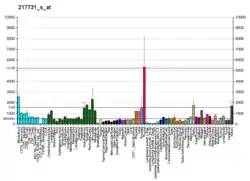| ITM2B | |||||||||||||||||||||||||||||||||||||||||||||||||||
|---|---|---|---|---|---|---|---|---|---|---|---|---|---|---|---|---|---|---|---|---|---|---|---|---|---|---|---|---|---|---|---|---|---|---|---|---|---|---|---|---|---|---|---|---|---|---|---|---|---|---|---|
| Identifiers | |||||||||||||||||||||||||||||||||||||||||||||||||||
| Aliases | ITM2B, ABRI, BRI, BRI2, BRICD2B, E25B, E3-16, FBD, imBRI2, RDGCA, integral membrane protein 2B | ||||||||||||||||||||||||||||||||||||||||||||||||||
| External IDs | OMIM: 603904 MGI: 1309517 HomoloGene: 7388 GeneCards: ITM2B | ||||||||||||||||||||||||||||||||||||||||||||||||||
| |||||||||||||||||||||||||||||||||||||||||||||||||||
| |||||||||||||||||||||||||||||||||||||||||||||||||||
| |||||||||||||||||||||||||||||||||||||||||||||||||||
| |||||||||||||||||||||||||||||||||||||||||||||||||||
| |||||||||||||||||||||||||||||||||||||||||||||||||||
| Wikidata | |||||||||||||||||||||||||||||||||||||||||||||||||||
| |||||||||||||||||||||||||||||||||||||||||||||||||||
Integral membrane protein 2B (ITM2B or BRI2) is a protein that in humans is encoded by the ITM2B gene.[5][6]
ITM2B or BRI2 is a gene located on chromosome 13. The gene is connected to familial Danish dementia and familial British dementia causing amyloid and pre-filbrillar effects similar to those seen in Alzheimer's.
References
- 1 2 3 GRCh38: Ensembl release 89: ENSG00000136156 - Ensembl, May 2017
- 1 2 3 GRCm38: Ensembl release 89: ENSMUSG00000022108 - Ensembl, May 2017
- ↑ "Human PubMed Reference:". National Center for Biotechnology Information, U.S. National Library of Medicine.
- ↑ "Mouse PubMed Reference:". National Center for Biotechnology Information, U.S. National Library of Medicine.
- ↑ Pittois K, Deleersnijder W, Merregaert J (Nov 1998). "cDNA sequence analysis, chromosomal assignment and expression pattern of the gene coding for integral membrane protein 2B". Gene. 217 (1–2): 141–9. doi:10.1016/S0378-1119(98)00354-0. PMID 9795190.
- ↑ "Entrez Gene: ITM2B integral membrane protein 2B".
Further reading
- Rostagno A, Tomidokoro Y, Lashley T, et al. (2005). "Chromosome 13 dementias". Cell. Mol. Life Sci. 62 (16): 1814–25. doi:10.1007/s00018-005-5092-5. PMID 15968464. S2CID 40812895.
- Ernst B, Dalby MA, Dalby A (1970). "Luria testing in demented patients". Acta Neurol. Scand. 46 (S43): Suppl 43:97–8. doi:10.1111/j.1600-0447.1970.tb01106.x. PMID 5466275. S2CID 221441989.
- Vidal R, Frangione B, Rostagno A, et al. (1999). "A stop-codon mutation in the BRI gene associated with familial British dementia". Nature. 399 (6738): 776–81. Bibcode:1999Natur.399..776V. doi:10.1038/21637. PMID 10391242. S2CID 34349437.
- Vidal R, Revesz T, Rostagno A, et al. (2000). "A decamer duplication in the 3' region of the BRI gene originates an amyloid peptide that is associated with dementia in a Danish kindred". Proc. Natl. Acad. Sci. U.S.A. 97 (9): 4920–5. doi:10.1073/pnas.080076097. PMC 18333. PMID 10781099.
- Hu RM, Han ZG, Song HD, et al. (2000). "Gene expression profiling in the human hypothalamus-pituitary-adrenal axis and full-length cDNA cloning". Proc. Natl. Acad. Sci. U.S.A. 97 (17): 9543–8. Bibcode:2000PNAS...97.9543H. doi:10.1073/pnas.160270997. PMC 16901. PMID 10931946.
- Fleischer A, Ayllón V, Dumoutier L, et al. (2002). "Proapoptotic activity of ITM2B(s), a BH3-only protein induced upon IL-2-deprivation which interacts with Bcl-2". Oncogene. 21 (20): 3181–9. doi:10.1038/sj.onc.1205464. PMID 12082633. S2CID 27728145.
- Austen B, el-Agnaf O, Nagala S, et al. (2003). "Properties of neurotoxic peptides related to the BRI gene". Biochem. Soc. Trans. 30 (4): 557–9. doi:10.1042/BST0300557. PMID 12196136.
- Strausberg RL, Feingold EA, Grouse LH, et al. (2003). "Generation and initial analysis of more than 15,000 full-length human and mouse cDNA sequences". Proc. Natl. Acad. Sci. U.S.A. 99 (26): 16899–903. Bibcode:2002PNAS...9916899M. doi:10.1073/pnas.242603899. PMC 139241. PMID 12477932.
- Akiyama H, Kondo H, Arai T, et al. (2004). "Expression of BRI, the normal precursor of the amyloid protein of familial British dementia, in human brain". Acta Neuropathol. 107 (1): 53–8. doi:10.1007/s00401-003-0783-1. PMID 14586629. S2CID 20479606.
- Choi SI, Vidal R, Frangione B, Levy E (2004). "Axonal transport of British and Danish amyloid peptides via secretory vesicles". FASEB J. 18 (2): 373–5. doi:10.1096/fj.03-0730fje. PMID 14656991. S2CID 11582717.
- Gerhard DS, Wagner L, Feingold EA, et al. (2004). "The status, quality, and expansion of the NIH full-length cDNA project: the Mammalian Gene Collection (MGC)". Genome Res. 14 (10B): 2121–7. doi:10.1101/gr.2596504. PMC 528928. PMID 15489334.
- Matsuda S, Giliberto L, Matsuda Y, et al. (2005). "The familial dementia BRI2 gene binds the Alzheimer gene amyloid-beta precursor protein and inhibits amyloid-beta production". J. Biol. Chem. 280 (32): 28912–6. doi:10.1074/jbc.C500217200. PMID 15983050.
- Fotinopoulou A, Tsachaki M, Vlavaki M, et al. (2005). "BRI2 interacts with amyloid precursor protein (APP) and regulates amyloid beta (Abeta) production". J. Biol. Chem. 280 (35): 30768–72. doi:10.1074/jbc.C500231200. PMID 16027166.
- Ghiso J, Rostagno A, Tomidokoro Y, et al. (2006). "Genetic alterations of the BRI2 gene: familial British and Danish dementias". Brain Pathol. 16 (1): 71–9. doi:10.1111/j.1750-3639.2006.tb00563.x. PMC 8095812. PMID 16612984.
This article is issued from Wikipedia. The text is licensed under Creative Commons - Attribution - Sharealike. Additional terms may apply for the media files.





